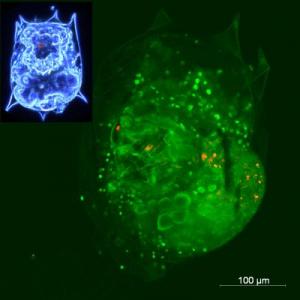It is possible that nanomaterials do not accumulate in higher organisms * The fear of this accumulation is at the center of the criticism of various parties on the continuation of research in the field of nanotechnology

A new study shows that while engineered nanomaterials are able to be emitted from the lowest levels of the food chain from unicellular organisms to higher multicellular organisms, their quantity was relatively low and no evidence of the accumulation of these substances in higher organisms was found. These preliminary results observed by researchers from the National Institute of Standards and Technology (NIST) suggest that the particular nanomaterials tested will not accumulate in invertebrates.
The same properties that make the engineered nanoparticles effective in a number of applications - biological and environmental stability, small dimensions, good solubility in aqueous solutions and the absence of toxicity to living organisms - also raise concerns about their long-term impact on the environment. The researchers at the institute wanted to determine whether nanoparticles could pass between the various items in a food-chain model, and if indeed this happens, whether the passage leads to a significant accumulation in one of the species (bioaccumulation) - that is, an increase in the concentration of the material in a certain production over time and in the increase (biomagnification) - That is, a graded increase in the amount of material that was in the prey and was transferred to the predator as a result of eating it.
In their research, the team examined the accumulation, removal and nutritional toxicity of two types of luminous quantum dots using a simple, laboratory food chain with the help of two microscopic aquatic creatures - Tetrahymena pyriformis, a single-celled protozoan from the family of ciliates, and Brachionus calyciflorus, fed by it. The process in which material is transferred between the different levels in the food chain from the prey to the predator is called "trophic transfer". Quantum dots are nanoparticles engineered to glow with high intensity at certain wavelengths. These materials are tested in a variety of applications, including tags for quick and easy identification in the fields of medicine and diagnostics. Their fluorescence was used to detect the presence of the quantum dots in both creatures.
The researchers found that both types of quantum dots were easily absorbed by the production T. pyriformis and that they retained their fluorescence even when this production was eaten by production higher up the food chain. This observation helped determine that the quantum dots were transferred within the food chain as intact nanoparticles and that absorption as food is one of the ways that enable such a transfer. The researchers noted that, "We must proceed with caution, however, when we extrapolate from our laboratory results to the natural environment."
"Our findings showed that although dietary transition of quantum dots did occur in this simple model of the food chain, they did not accumulate significantly in any of the organisms," says the lead researcher. "Although the research indicates that quantum dots do not pose a significant risk of accumulation in the food chain of marine invertebrates, there is a need for additional experiments, beyond those conducted in the laboratory, and more accurate methods for quantifying the nanoparticles transferred in order to draw reliable conclusions regarding environmental systems."

5 תגובות
A small correction to the photo:
ROTIFER is a multicellular eukaryotic organism and not a bacterium.
http://en.wikipedia.org/wiki/Rotifer
Ami:
No one said (not even the researchers) that this study can be concluded about other substances.
All in all, I don't think there are any pretensions in the publication beyond those that the research did justify and my argument was about the comparison with carbon which is not justified.
When you say that something accumulates, it means that its amount increases as more time passes.
Even if you interpret the image correctly (and I'm not sure about that) you don't see the time dimension in it.
Look at the picture dear friend,
The accumulated material glows through the protozoa and the cilia quite clearly - isn't it?
And if this protozoan does not accumulate this specific substance given to it, will it accumulate others? And will other single cells manage to accumulate it?
good week
Ami:
I do not claim that the research is sufficient, but nevertheless it seems to me that your comparison is not justified.
The researchers noted (it is not explained how they tested) that there is no accumulation of nanomaterials at any of the levels.
I guess no one would claim that about carbon that actually accumulates (and it was missing that it didn't)
It is common to think that only 10% of the material that built the lower level passes from one tropical level to the next. At the same time, it must be remembered that even with this loss of 90% of the material from level to level, there are nevertheless huge creatures at the top of the food chain such as humans. want to say that even if from the simple plant that fixed carbon and passed to an insect that chewed it and that was eaten by a lizard that was eaten by a small mammal that was eaten by a larger mammal that was caught and eaten by a human, nevertheless all (all all!!) all the carbon ends up From the same base of a food chain.
Therefore, the experiment described here is not satisfactory and even shows that there is a transition of nanomaterials from one trophic level to another. There is a certain accumulation with a certain efficiency and it is possible (and certainly probable) that in different tropical stages this efficiency changes. Therefore, this research should be viewed with suspicion, or at the very least, its initial results should not be accepted as a rule that allows the wild use of nanomaterials without strict regulation of their future fate.
Greetings friends,
Ami Bachar